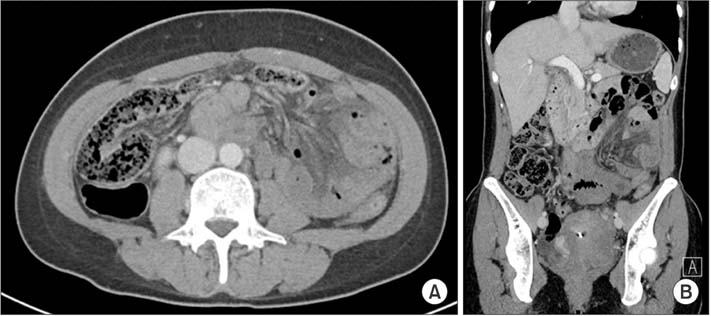Ann Surg Treat Res.
2015 Nov;89(5):275-277. 10.4174/astr.2015.89.5.275.
Left paraduodenal hernia accompanying chylous ascites
- Affiliations
-
- 1Department of Surgery, Korea University Guro Hospital, Korea University College of Medicine, Seoul, Korea. jyjclick@korea.ac.kr
- KMID: 2095534
- DOI: http://doi.org/10.4174/astr.2015.89.5.275
Abstract
- Paraduodenal hernia is by far the most common form of congenital internal hernia. Chylous ascites is an accumulation of lymphatic fluid in the peritoneal cavity. It develops when the lymphatic system is disrupted due to traumatic injury or obstruction. A 40-year-old, woman showed up to the Emergency Department with severe, colicky abdominal pain. Tenderness and rebound tenderness were observed at the left abdomen. Abdominal CT confirmed a cluster of dilated proximal small bowel loops with ischemic change, without ascites. The patient underwent an emergency surgery to relieve bowel ischemia. As soon as the peritoneum was exposed, 1.5 L of chylous fluid was found. A hernial sac was found along the posterior side of the mesentery of the inferior mesenteric artery. We resected the hernial sac and pulled out the herniated small bowel. On the sixth day after the surgery, she was discharged without any complication.
Keyword
MeSH Terms
Figure
Reference
-
1. Hussein M, Khreiss M, Al-Helou G, Alaeddine M, Elias E, Abi Saad GS. Laparoscopic repair of a left paraduodenal hernia presenting with acute bowel obstruction: report of a case. Surg Laparosc Endosc Percutan Tech. 2012; 22:e28–e30.2. Al-Khyatt W, Aggarwal S, Birchall J, Rowlands TE. Acute intestinal obstruction secondary to left paraduodenal hernia: a case report and literature review. World J Emerg Surg. 2013; 8:5.3. Cardenas A, Chopra S. Chylous ascites. Am J Gastroenterol. 2002; 97:1896–1900.4. Dritsas ER, Ruiz OR, Kennedy GM, Blackford J, Hasl D. Paraduodenal hernia: a report of two cases. Am Surg. 2001; 67:733–736.5. Falk GA, Yurcisin BJ, Sell HS. Left paraduodenal hernia: case report and review of the literature. BMJ Case Rep. 2010; 10.1136/bcr.04.2010.2936.6. Lee SE, Choi YS. Left paraduodenal hernia combined with acute cholecystitis. Ann Surg Treat Res. 2014; 86:217–219.7. Madding GF, McLaughlin RF, McLaughlin RF Jr. Acute chylous peritonitis. Ann Surg. 1958; 147:419–422.8. Kinmonth JB. Disorders of the circulation of chyle. J Cardiovasc Surg (Torino). 1976; 17:329–339.9. Koh YX, Chng JK, Tan HC, Chung AY. Intestinal torsion causing chylous ascites: a rare occurrence. Singapore Med J. 2013; 54:e88–e90.



